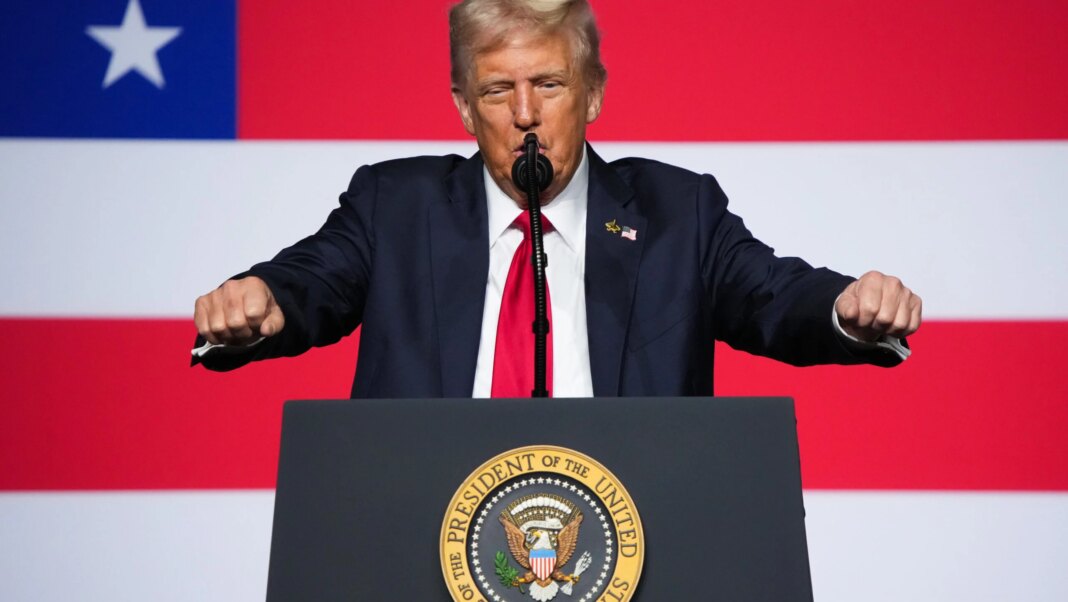The Trump Administration’s Bold Shift: Embracing Project 2025 amid Government Shutdown
President Donald Trump is undergoing a remarkable transformation during his 2024 campaign, openly adopting the tenets of the controversial conservative framework known as Project 2025. Once a subject of derision and a source of tension within his own camp, this blueprint is rising to prominence as key figures within the administration leverage the looming government shutdown to push forward their agenda of reducing the federal workforce and targeting Democratic states.
Trump’s Shift in Strategy
In a striking move, Trump took to his Truth Social platform to announce a meeting with budget chief Russ Vought, a prominent figure behind Project 2025. In his post, Trump indicated he would seek Vought’s advice on which federal agencies, deemed “political scams” by the former president, should face cuts. The significance of this meeting cannot be overstated—it marks a departure from Trump’s prior attempts to distance himself from the project that now appears central to his objectives.
This change in rhetoric is particularly noteworthy given that during much of the past year, Trump publicly derided Project 2025. He positioned it as a radical overhaul steeped in conservative ideology, a point of contention that his political rivals seized upon to paint a stark picture of the potential consequences of a second Trump term.
The Reactions of Political Rivals
Democratic adversaries, including President Joe Biden and Vice President Kamala Harris, have turned Project 2025 into a focal point of their campaigns, using it to warn voters of the potential extremities associated with a Trump presidency. At the Democratic National Convention, a substantial replica of the Project 2025 manifesto served as a visual reminder of this cautionary narrative.
Ammar Moussa, a former spokesperson for both Democratic campaigns, articulated the frustration many feel, stating, “Donald Trump and his stooges lied through their teeth about Project 2025, and now he’s running the country straight into it.” This sentiment highlights a growing anxiety among Democrats who feel vindicated yet powerless against the implementation of policies they warned about.
Understanding Project 2025
So, what exactly is Project 2025? This ambitious initiative, drafted by the Heritage Foundation, outlines a sweeping agenda that aligns closely with many of Trump’s proposed policies—especially regarding immigration control and the reorganization of federal agencies. However, it goes beyond his platform, advocating measures like banning pornography and withdrawing approval for abortion medication, both of which Trump and his team had previously sought to avoid discussing.
Despite his claims of ignorance regarding the project—a narrative he maintained throughout 2024—the connections between Trump and the authors of Project 2025 are numerous and undeniable. Key figures such as John McEntee and Paul Dans have been instrumental in shaping the policies he now openly embraces.
Embracing Conservative Allies
As Trump consolidates power within his second administration, he has appointed many authors and supporters of Project 2025 to significant roles. This includes Vought, as well as “border czar” Tom Homan and other hard-liners. The composition of his administration reflects a shift from denial to a full embrace of the very ideas he once publicly rejected.
Dans, the project’s former director, expressed his satisfaction at the gradual integration of the project’s proposals into administration policy, celebrating the fulfillment of their vision for immediate governmental action under a Trump presidency.
The Shutdown as a Political Tool
The current government shutdown presents a pivotal opportunity for the Trump administration to accelerate its agenda. Traditionally, federal shutdowns result in a temporary furlough for non-essential personnel; however, this time, there are indications of a more aggressive strategy. The Office of Management and Budget has prepared for mass firings of federal workers, a departure from past practices.
Vought has reinforced this stance in private communications, suggesting immediate layoffs rather than the customary furloughs, suggesting a fundamental shift in how the Trump administration approaches budgetary constraints and governmental staffing.
Targeting Democratic Initiatives
Moreover, the Trump administration is seizing the shutdown to target funding for projects associated with Democratic leaders, including the cancellation of billions allocated for green energy initiatives and other transportation projects in Democratic strongholds. This tactic serves dual purposes: undermining Democratic priorities and further asserting executive power over the budgetary process.
Aiming for Executive Dominance
At the heart of Project 2025 lies an ambition to centralize power within the presidency, a theme that is becoming increasingly evident in current governance. Vought has articulated a vision wherein the Office of Management and Budget becomes a critical player in dictating federal policy, arguing that it should operate as an extension of the president’s will.
This consolidation of power evokes reactions from both sides of the aisle, with some Republicans praising the potential effectiveness of this approach while Democrats raise alarms over the implications for checks and balances.
Legislative Power Dynamics
House Speaker Mike Johnson has echoed the sentiment that the shutdown confers considerable power to Trump and his team, effectively sidelining the legislative branch. This perspective raises critical questions about the constitutional balance of power and the potential ramifications of an executive branch unrestrained by legislative oversight.
Shalanda Young, the director of the Office of Management and Budget under Biden, has challenged this narrative, contending that inherent constitutional limits should rein in such executive overreach and that the responsibility to check presidential power has not been fulfilled by Congress.
The unfolding political landscape reveals profound implications for governance and the balance of power in the U.S. As Trump reasserts his influence and embraces the principles of Project 2025, it is clear that his administration is preparing for significant changes that will resonate far beyond the current political climate.



